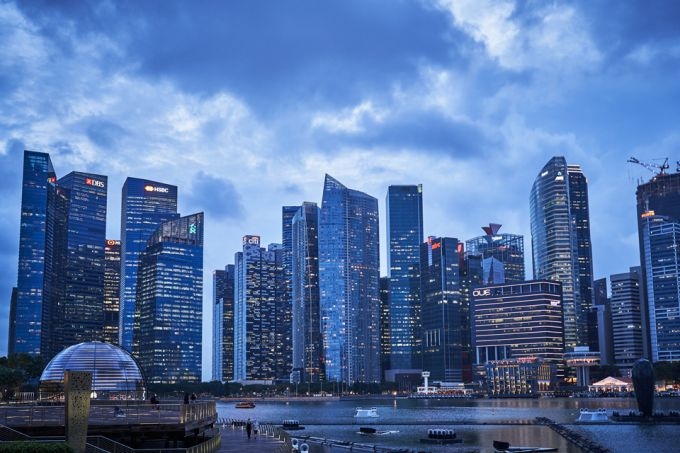Singapore's CBD will never be the same again

SINGAPORE'S office market, with its roughly 8 million square metres (sq m) of completed space, is under stress.
Islandwide office vacancy rate dipped for the second consecutive quarter to 11.8 per cent in the fourth quarter of 2020. Office space net demand for last year fell by 79,000 sq m, contrasting with net positive demand of 155,000 sq m in 2019.
In the near term, the market will look to ride on economic recovery amid the roll-out of vaccines to fight the Covid-19 pandemic. But the bigger challenge comes from technology enabling many office workers to work from anywhere. Could office buildings hollow out and the Central Business District (CBD) lose its relevance?
Flight to quality
While we may leave the pandemic behind us and return to normal eventually, that "new normal" is unlikely to include the daily commute to purpose-built offices for legions of workers. The future model is likely to be a mix of working from office and remotely.
Companies will use physical office space as a corporate branding tool and a base for knowledge workers to come together to collaborate. The physical office will exist to enable in-person interactions among colleagues and with business associates. Such interactions can result in closer relationships, better productivity and more creativity.
With the hybrid model, aggregate demand for office space will fall. Put simply, less time spent in office equals less office space requirement.
Against this backdrop, there will be a flight to quality. The smaller total budget for office space can be spent on securing higher grade space. For many businesses, real estate cost is not a significant part of total costs, so expect businesses that are doing well to go for premium office digs or iconic ones such as St James Power Station, which will be home to the global headquarters of technology company Dyson.
Another trend could be for big businesses to have multiple locations under the hub-and-spoke model. This can primarily cater for business contingency and to a lesser extent provide convenience to staff. An isolated public health scare or other incident could shut down one location, while leaving another intact.
Given this shift, the CBD looks set for a major transformation. With technology and better transport connectivity, particularly with the growing mass rapid network, the clustering of banks, financial services firms, lawyers and accountants in the district may become a relic.
Some numbers put things in perspective. The latest data from the Urban Redevelopment Authority (URA) showed the central region office rental index falling 8.5 per cent last year, after already falling 3.1 per cent in 2019.
Data from Cushman & Wakefield cited earlier by The Business Times showed that the Downtown Core area - which includes the CBD - saw a contraction in demand for office space by 16,000 sq m in Q4 last year. Downtown Core vacancy rates rose to 10.3 per cent in the quarter, creeping upfrom 9.9% in Q3 2020.
The CBD will transform from being an office-centric space as total demand for office goes down. It will need to become a more complete work, play and live precinct.
Best-in-class office buildings in the CBD will continue to attract tenants, but older and outdated office buildings will struggle and over time make way for residential developments.
Indeed, a special purpose vehicle managed by Allianz Real Estate is paying S$634 million or S$34,121 per square metre for a 50 per cent stake in CBD office property OUE Bayfront. It speaks to continued - but selective - demand by institutional investors for prime office space.
Market forces will lead to more churn in CBD office buildings and the active take-up of the URA's incentive scheme introduced in 2019 to rejuvenate the CBD. The push will come from owners of failing buildings and the pull from developers who want to deliver projects that meet new needs.
Regional centres such as Jurong, Paya Lebar, Punggol or Woodlands can complement the CBD, as a company may have its hub in the CBD and a spoke elsewhere. Given the technology and transport connectivity, a business may also be agnostic when choosing between Jurong or the CBD to be its base.
Fortunately for Singapore, workers who can work anywhere may still want to be based here because of transport connectivity, quality of healthcare and schools, social stability, safety, clean air and urban planning. The future should belong to good office buildings that provide a great working environment and are located in neighbourhoods with good transport connectivity and amenities useful to workers.
Relatively new integrated developments such as Guoco Tower in Tanjong Pagar and Paya Lebar Quarter may offer what office space occupiers are looking for. People get to use spaces with high specifications, while enjoying easy access to food and services from the supporting retail component, use of public spaces and connection to neighbourhoods with character.
Flexibility
The other key challenge for office landlords is to offer users flexibility. Buildings can have meeting rooms and auditoriums for shared use. Some floors or parts of them can be kept for occupiers to lease for a couple of months.
In recent years, co-working operators have grown in Singapore, offering fun working spaces and the opportunity to be part of a community.
More critically, these operators offer flexibility. Co-working spaces may offer contracts with terms of 12 months and options for shorter periods, versus typical office lease terms of two to three years. Coworking operators allow users the choice of using just a desk, paying based on the number of days of usage, and paying for meeting rooms only when needed.
Flexibility will increasingly matter to office space users. Large businesses need to adjust space requirements quickly to respond to changing business needs, as business models get tweaked constantly and business cycles turn rapidly.
The future will also see entrepreneurs seizing on technological advancements to create new disruptive businesses such as in fintech, or in artificial intelligence.
In an increasingly sophisticated business space in Singapore, there will be many freelancers, be it knowledge workers who are seeking better work-life balance, experienced hands who have left full time work but want to remain engaged, or outsourced service providers of big corporates. For startup businesses and freelancers, use of co-working spaces minimises capital outlay and saves time as there is a ready-made office space.
Landlords would be wise to offer a mix of the standard leases of two to three years or more, which some tenants want, and lease terms of much shorter durations to cater to other tenants or tenants who want a mix of core and flexible space.
Whether winners will be landlords who have their own co-working operations, those who adopt some coworking elements, or the independent co-working operators, is one question to watch. Right now, the tenant is king.
Investors and property valuers would need to study carefully the plans listed groups, such as United Industrial Corporation, have for their large Singapore office portfolio. They should ask what the office real estate investment trusts are doing on asset management to correctly assess the value of particular office buildings.
Location still matters. But office landlords will need to offer space with tailored specifications, while flexing their muscle in asset and property management.
Net property income generated may vary substantially depending on whether a building can meet the new needs of occupiers. This new concrete jungle calls for survival of the fittest.




